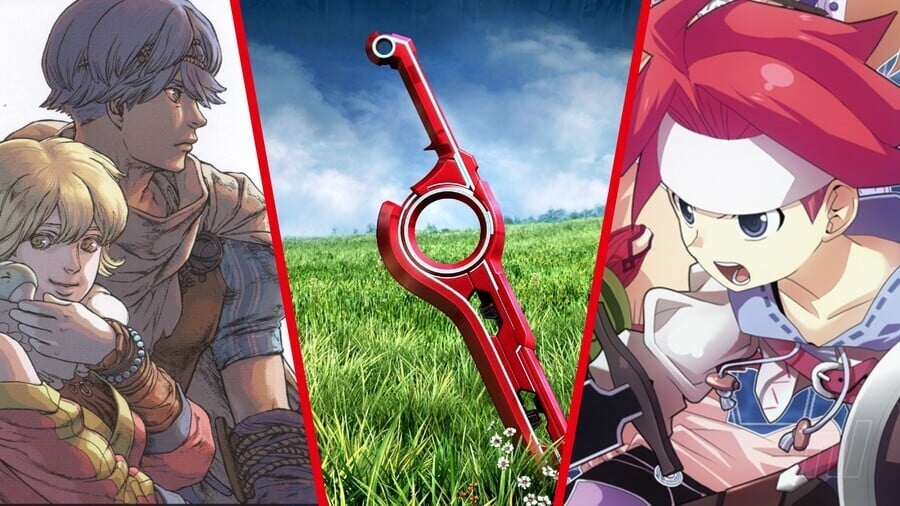
Monolith Soft has become one of the most recognisable of Nintendo's first-party developers in recent times. Led by legendary RPG writer and director Tetsuya Takahashi, the studio is renowned for the monolithic (pun intended) Xenoblade series. Combining MMORPG-style, memorable worlds, stunning music, and philosophical writing, the Xenoblade Chronicles franchise has taken the world by storm. Monolith Soft's history, however, is as monolithic as its now-flagship series.
Takahashi is perhaps most famous for co-writing and directing the seminal PS1 RPG Xenogears, which he created during his time at Squaresoft. But in the years following Xenogears' 1998 release, Square decided to focus all of its energy on the Final Fantasy series. Xenogears underperformed in the eyes of the company, but Takahashi had big plans for his proposed franchise, of which Xenogears was meant to be 'Episode 5'.
Xenogears didn't fit into Square's future, so Takahashi — along with Hirohide Sugiura (producer of Ehrgeiz: God Bless the Ring) and Yasuyuki Honne (art director of Xenogears and Chrono Cross) — founded Monolith Soft on 1st October 1999. The company was quickly acquired by majority stake by Namco, who published the Monolith's early titles.
But even in the early days, Monolith Soft started on the right foot with Nintendo.
Play your cards right
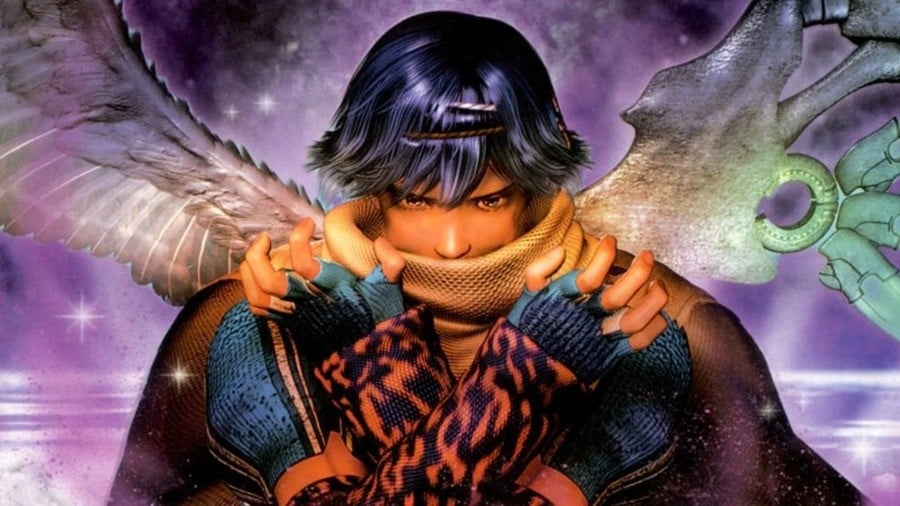
In the early 2000s, Takahashi was ready to carry on his Xeno-saga, and the company's first new game came to be the next 'entry' in the pseudo-Xeno series – Xenosaga Episode I. While this was a PlayStation 2 exclusive, some of the younger staff banded together under Honne and tri-Crescendo founder Hiroya Hatsushiba to create an entirely new turn-based RPG for the GameCube, Baten Kaitos: Eternal Wings and the Lost Ocean.
The development of this card-based RPG took around two years in total, and it had an all-star cast on board. Masato Kato of Chrono Trigger, Final Fantasy VII, and Xenogears fame penned the story, with music from Valkyrie Profile and Tales of series composer Motoi Sakuraba, alongside multiple other Xeno and Chrono alums.
The GameCube wasn't known for its RPGs, but in a 2004 interview, producer Shinji Noguchi said of the decision: "We wanted to offer a true RPG for GameCube users and eventually establish a top franchise for the platform."
Released in 2003 in Japan, 2004 in North America, and 2005 in Europe, Baten Kaitos still looks utterly stunning today. The game's card system goes well beyond battle mechanics, with the entire world built upon it. These 'Magnus' are the essence of everything. There are over 1,000 unique cards in the game, from collectible constellations to magic spells, armour, and the like. And a large chunk of these cards change as in-game time passes – food rots, fire swords burn out, and milk pasteurises. As a result, a 100% "speedrun" of this game takes nearly 340 hours.
Baten Kaitos' poor sales and competition from an entry in an established JRPG series (and arguably console-defining RPG), Tales of Symphonia, initially hurt that prospect. But Baten Kaitos Origins was eventually greenlit due to the first game's warm critical reception. Published this time by Nintendo, the prequel refined the battle system and streamlined a lot of elements, and it was as well-received as its predecessor, but the Wii was announced towards the end of development. Sugiura recalls the company determining that porting the game "was not worth the cost and labour hours," which ultimately led to the 2006 game never releasing in Europe, which is a darn shame.
At the same time, Monolith Soft had also been working on Xenosaga Episode II and III, alongside a DS port of the first two games (which never left Japan), so Western Nintendo fans only had this "anti-Xenosaga" to go on.
After relations with Namco began to sour and the merger to create Bandai Namco took place, the company felt it was being restricted creatively. Thus, a chance consultation with Shinji Hatano, then executive director at Nintendo, inspired Monolith to break away from Namco, and Nintendo acquired an 80% stake in the company.
Dual screen dreams
Under the Big N, Monolith Soft made the jump to a new generation, as well as portable systems. While the studio already had ideas for its first Wii game before joining Nintendo in Disaster: Day of Crisis, the company was drafted in to help with Super Smash Bros. Brawl. The studio's first title under Nintendo was the Japan-only DS action RPG Diablo-like Soma Bringer.
Plundering into dungeons with friends online was the name of the game here, with six unique classes and a loot system to dive into. Takahashi was the person behind this one and wanted to create a game you could play in short bursts. And while Soma Bringers' combat went through a few iterations, it was – unusually – settled and completed before the story was established. Written by Soraya Saga, Takahashi's wife (co-writer on Xenogears and Xenosaga), with music from Yasunori Mitsuda (Chrono Trigger, Cross, Xenogears), it was much more straightforward in scope than Monolith's other games. However, it was still text-heavy, meaning this one is a real challenge for non-Japanese speakers.
That wasn't the end of 2008 releases for the company, whose only non-RPG, Disaster: Day of Crisis, finally launched on the Wii. An arcade-like adventure, the game has you surviving natural disasters and saving citizens. Unfortunately, developmental woes and delays meant that this action game suffered and, as a result, wasn't well loved by critics. It launched in Europe but never came out in North America.
But Monolith was also hard at work with other DS RPGs. Super Robot Taisen OG Saga: Endless Frontier and its 2010 sequel, Endless Frontier Exceed, saw the company back with Bandai Namco. These turn-based crossover RPGs pulled inspiration from PS2's Namco x Capcom, a 2005 crossover game that Monolith Soft worked on which combines the worlds of Super Robot Wars, Xenosaga, and other Monolith games. Working with Banpresoft, only the first of the two games left Japan, but the unique turn-based combat and visuals showed Monolith's continued flair for originality.
2009's Dragon Ball Z: Attack of the Saiyans received similar praise, a beautifully animated turn-based RPG that adapts the 23rd Tenkaichi Budokai arc from the hugely popular manga series. With a timing-based guard mechanic, many thought this was one of the best RPGs to use the Dragon Ball IP, although it still had limited appeal.
But all of these smaller titles were leading to something much bigger, and in the background, Takahashi had some big ideas for Nintendo.
The Chronicles of the Beginning of the World
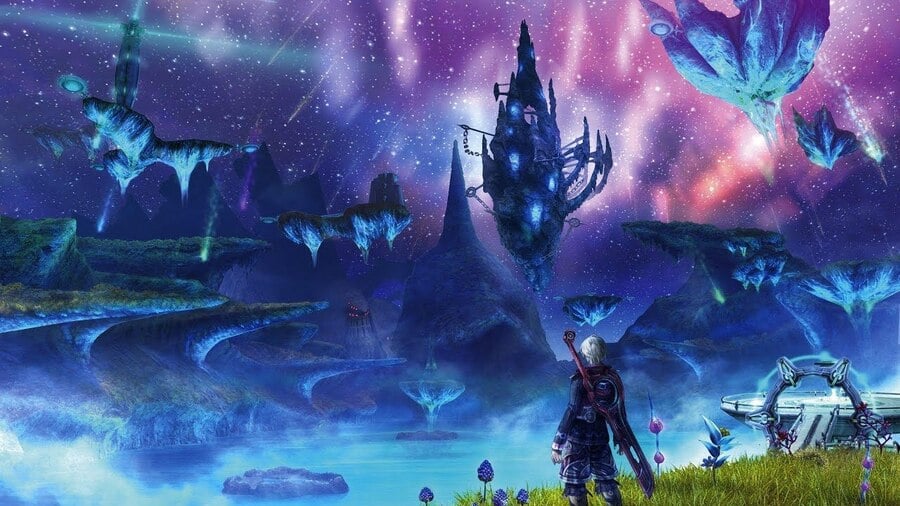
Takahashi was still determined to carry on the Xeno series name, despite Xenosaga having to be condensed down from six to three games. Following Xenosaga III, staff morale was low, so when coming up with a new project, Takahashi recalled an idea he came up with years ago — people living on the bodies of dead giants or 'gods'. With other senior staff and artist Honne, the team created a 3D model of these two titans, frozen in eternal battle. The team presented the model to Nintendo, and producer Hitoshi Yamagami remembers being shocked that Takahashi didn't have the "finer details" nailed down, but it was enough to pique his interest.
So, with this vision, Nintendo brought in Genki Yokota to help direct the game alongside Koh Kojima, who wrote Baten Kaitos Origins' story. Thus, Monado: The Beginning of the World was in production.
Nintendo, Yamagami, and Yokota proved to be a big help — and big motivators — in creating this epic "open-world" RPG. Monolith Soft had taken on feedback from Baten Kaitos and Xenosaga about being "old-fashioned" and wanted to focus on creating something new.
With the proposed launch date looming, the team ran into difficulties. Takahashi proposed multiple suggestions to Yamagami to get the game out on time, but Yamagami refused, instead going to Nintendo to ensure the team had enough time to complete their full vision. Even the late Satoru Iwata left a mark on the game in a small but significant way. As a way of honouring Takahashi, "who poured his soul into making this and who has been working on the Xeno series," Iwata wanted the game to bear the Xeno moniker. And it's here where Xenoblade — or Xenoblade Chronicles — was born.
For the game's scenario, Takahashi received help from Yuichiro Takeda (who previously worked with Takahashi on Xenosaga: The Animation) and Yurie Hattori (a scenario planner at Nintendo). Takahashi's original concept went through multiple iterations, with debates – as revealed in an Iwata Asks interview –about potential party member betrayals and whether the main character, Shulk, would be a silent protagonist. The final product is, arguably, one of Takahashi's most focused.
Mitsuda returned to compose the game's ending theme, but Xenoblade Chronicles also brought the world a lot of new talent. Alongside veteran Yoko Shimomura, ACE+ and Manami Kiyota made their marks on the video game music world. Xenoblade Chronicles became only the second Xeno title to receive a global release (previously, only Xenosaga Episode II had been launched worldwide), with a fan campaign from Operation Rainfall helping the game get more attention.
Xenoblade Chronicles makes an extremely strong case for being one of the best RPGs of its generation. Its stunning open-world environments have echoes of Baten Kaitos' lush locales, and its hybrid MMORPG combat has a turn of the action-based party combat from Soma Bringer. Essentially, it took a lot from everything Monolith had done beforehand and only paved the way to greater things.
Crossing the zone
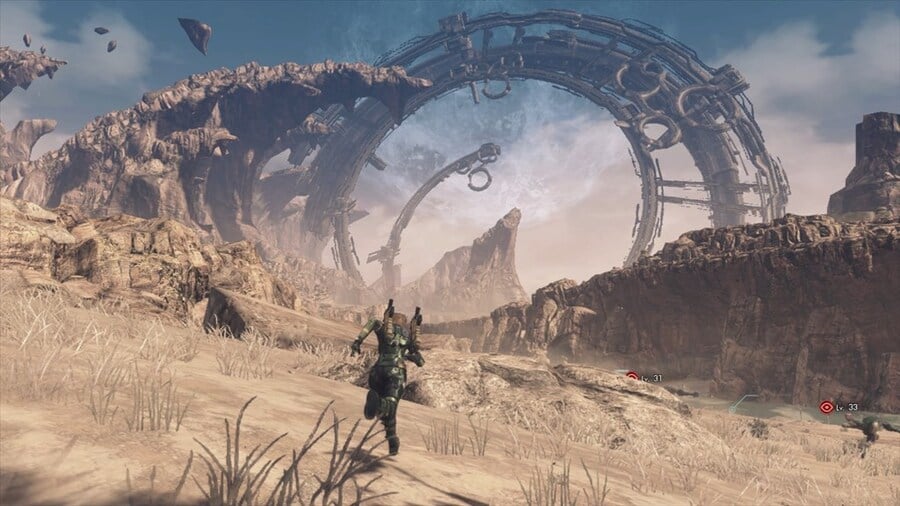
The close working relationship with Nintendo resulted in the company being trusted to assist with the development of both The Legend of Zelda: Skyward Sword and Animal Crossing: New Leaf, and to this day, Monolith Soft is closely involved in some of Nintendo's biggest franchise entries.
After Xenoblade Chronicles, Monolith Soft worked with Bandai Namco once again on Project X Zone for the 3DS in 2012. Scaling back from its god-sized world, the team returned to big crossover RPGs containing characters from Devil May Cry, Tales of Vesperia, Tekken, Xenosaga, and Resident Evil. The idea was all Bandai Namco's, but Monolith's work on Namco x Capcom once again proved invaluable to the company. A standalone sequel, Project X Zone 2, followed in 2015.
-
Further reading: Interview: Learning More About The 'Ultimate Crossover' RPG, Project X Zone 2, From Its Creators
Monolith Soft began working on the Wii U by supporting Nintendo on Pikmin 3 and Splatoon while also assisting with big 3DS titles The Legend of Zelda: A Link Between Worlds and Animal Crossing: Happy Home Designer. And while Shulk was busy smashing around Nintendo characters in Super Smash Bros. Wii U and 3DS, the next phase of the Xenoverse was brewing in the background, and it would mark Monolith Soft's foray into high definition with style.
X appeal
Teased in a 2013 Nintendo Direct as 'X', Xenoblade Chronicles X departed from the original game's more story-based focus, instead putting even more emphasis on the world and the sci-fi aspects that only crept into Xenoblade Chronicles in the latter half of the game.
Many names from the Wii game returned for this spiritual successor, with Attack on Titan composer Hiroyuki Sawano bringing his unusual electronic soundscape to the score. And, if you thought Xenoblade Chronicles' world was stunning, Mira has something to show you.
This grand scope didn't come without challenge for Monolith Soft. In an interview with Eurogamer, Takahashi felt the team learned to "create locations that are fun to explore on a budget" with Xenoblade Chronicles due to the Wii's restrictions. And while the Wii U was more powerful, Monolith Soft still pushed the system to its limit. The game barely fit on a Wii U disc and there were optional 10GB download packs if you bought a physical copy, which would reduce load times by installing frequently used data on your hard drive. Takahashi told Iwata that he originally wanted to create a "whole planet" for the game. Maybe one day!
What remains is a game that's trapped on old hardware and one that Xeno series fans are begging to see ported to Switch – which might be a challenge as Xenoblade Chronicles X heavily utilised the Wii U's gamepad (though you can play the whole game on the gamepad if you really want — so come on, Nintendo!). Nevertheless, the sheer scope and ambition of the game are unparalleled, even in other Xenoblade games. You can ride Mechs, play online with friends (or you could) to take down powerful monsters, and flesh out an entire city with alien races.
Xenoblade Chronicles X was a major indication of Nintendo's continued faith in Monolith Soft. The game became Nintendo's big game of the holiday season in 2015 after The Legend of Zelda: Breath of the Wild was delayed – which, interestingly, Monolith Soft was also helping out on.
The golden future
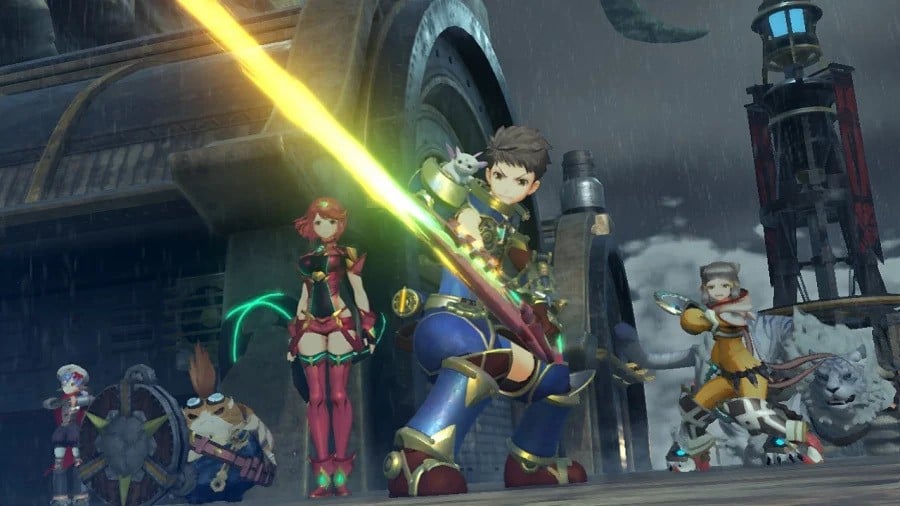
2017, the year the Switch hit shelves, was a huge one for Nintendo and Monolith Soft. Not only did Breath of the Wild release to rapturous praise, but Monolith returned to work on the ink-splatting sequel, Splatoon 2.
However, in 2014, ideas for a 'proper' sequel to Xenoblade Chronicles were set in motion. Following X's release, Takahashi wanted to go back to a more story-driven game with new characters and a new world, rather than revisit the Bionis and Mechonis from the first game.
Nintendo wanted to get the game on Switch early in the new console's life cycle, but the specs for the system weren't established by the time Monolith Soft started working on the game. Xenoblade Chronicles' New 3DS port showed how the team could condense something massive down to a much less powerful system, and X had proved that the studio could also create even bigger, more varied worlds.
With Xenoblade Chronicles 2, the team – with Masatsugu Saito leading the character designs – wanted to create a more anime-esque with more visually-expressive characters. So a melting pot of artists, from Tetsuya Nomura and Xeno veterans Tanaka and Soraya Saga, came together to create various characters and Blades, which you get from summoning them from Core Crystals through a gacha-like system.
The game was announced and released in 2017, featuring a world set on the "bodies" of "beings" (this time titans) in a sea of clouds. Simplifying the combat from both 1 and X – the latter of which had already helped to speed things up – Xenoblade Chronicles 2 layered even more systems on top of established ones to create an extraordinarily deep system. And, despite Switch sometimes struggling to run the game, it's a visual feast. Even KOS-MOS and T-elos from Xenosaga made cameos, along with Shulk and Fiora from 1, and Elma from X.
Xenoblade Chronicles 2 was a success and, before it was even released, Nintendo announced it would be getting a Season Pass with a DLC story episode. Torna - The Golden Country launched less than a year later and featured a full 30-hour campaign that added context to some of the events of the main game. The DLC was extremely well-received, and Xenoblade Chronicles 2 is still the best-selling game in the series to date.
New Horizons?
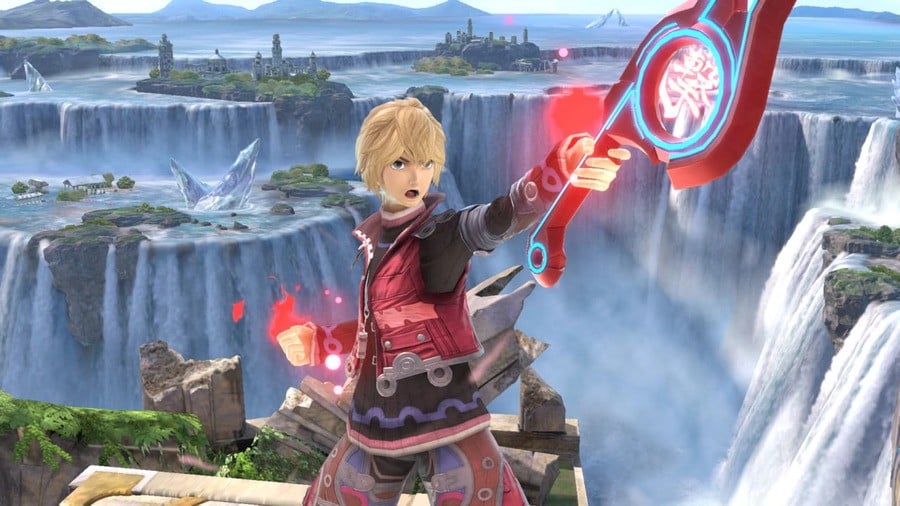
Xenoblade Chronicles 2's huge success and Shulk's return in Super Smash Bros. Ultimate — alongside Pyra & Myrtha becoming a combined DLC character — cemented Monolith Soft's reputation as a one of Nintendo's best studios. The company had opened studios in Nakameguro, Osaki, and Iidabashi – though the latter has since closed (and 2nd Production team is currently assisting Eiji Aonuma's Zelda team on Breath of the Wild 2). The studio's affinity for the skies, sea, sun, and all things beautiful, was put to use when drafted in to assist with 2020's Animal Crossing: New Horizons, too, presumably for environmental design.
The Switch was far from done with Xenoblade, with Xenoblade Chronicles: Definitive Edition hitting the console the same year, bringing rearranged music, improved visuals, and a brand new epilogue chapter that expanded on Shulk and Melia's story after the end of the main game.
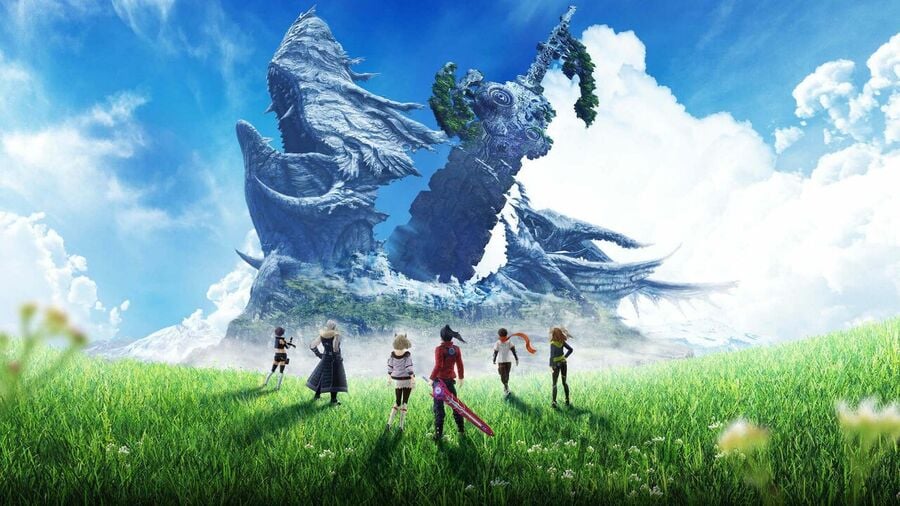
And then, there was Xenoblade Chronicles 3 in 2022. A surprise announcement (well, except for a leak the previous year), development started in 2018 and – like XC2 – was announced and released the same year. With noticeable improvements in the game's performance and visuals from both 2 and Torna, it felt like a "lesson learned" from all three previous entries in multiple different ways.
Takahashi considers Xenoblade Chronicles 3 a "stopping point" for the series, but certainly not the end of Xenoblade. Splatoon 3 has been keeping the developer busy, and its 'team B' is working on bringing us more sweet open-world Zelda, but we still have more to come from Noah and Mio's tale. We'll have to see what questions will be answered from Xenoblade Chronicles 3's conclusion in next year's story DLC and potentially what lies beyond for the Xenoblade Series.
In fewer than 25 years, Monolith Soft has gone from strength to strength, and the company's partnership with Nintendo has proven to be a hugely fruitful relationship for both parties. After feeling stifled all those years ago under Square, Takahashi and Monolith Soft get the creative freedom they need, and Nintendo gets a top-tier RPG series, plus invaluable support on some of its biggest IPs.
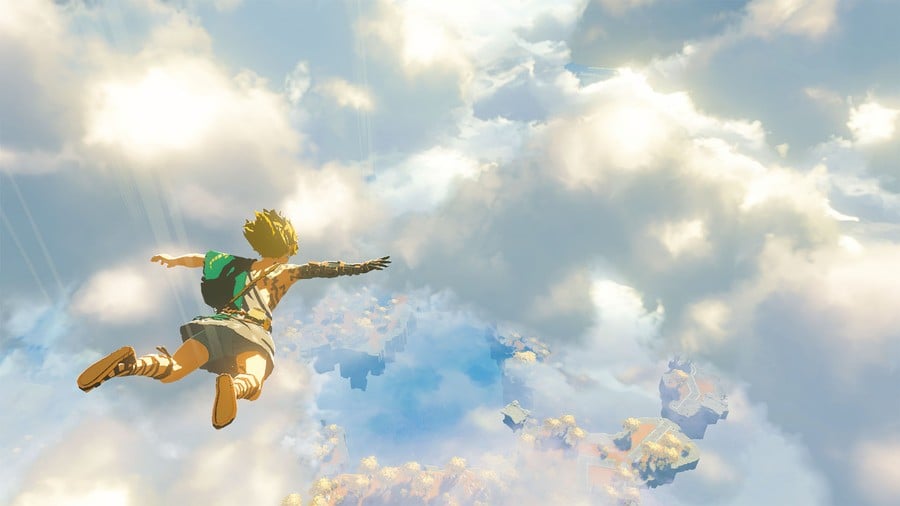
To say this has been a monolithic journey isn't an understatement.





Comments 62
I just realised you're the same Alana from the rpg podcast! Always really enjoyed your perspective on that.
Edit: just finished reading, fantastic stuff. I didn't know Monolith did a Dragonball RPG on DS. Will check it out.
Wow, you guys were so impressed with Monolith Soft helping out with Splatoon 3 that you made an entire article celebrating their history.
I believe X was the culmination of what Takahashi intended for the Xeno franchise ever since Xenogears. An open, story-driven sci-fi RPG with full-sized mechs. It was his dream. He wanted to continue the legacy of Gears. Sadly, although financially successful, didn't get to be played by a lot of people. Hopefully the series can get the attention it deserves in the near future, not to mention a proper sequel. Though you can argue XC3 is more akin to Gears in story.
I should really play a MonolithSoft game outside the Xenoblade series at some point. I'd also be pretty interested to know exactly what work they've done on the various Nintendo projects they've helped with. I remember someone saying they contributed to the map design in Breath of the Wild, but those landscapes were painfully boring compared to the average Xenoblade map.
A reboot of Baten Kaitos would be great, rational people should be bored of Xenoblade by now
Out of everything I could possibly hope for even more than say an HD Remake of OoT, a Super Mario RPG 2 or a slew of other hopes and dreams I'd say a return of Baten Kaitos would be top on my list!
I'd love a chance to play Baten Kaitos on a modern system. Always looks fascinating.
Monolithsoft isn't the developer Nintendo deserves, but its the one it needs.
Honestly, Xenoblade has become one of those franchises that I'd buy a Nintendo console for.
After being blown away by all the xenoblade games on the switch (never played the first on the Wii) I'm extremely impressed by this studio and hope for great things in the future.
I'll be catching up on a few their older titles via emulation. Especially xenogears story sounds heartwrenchingly fantastic.
@Mattock1987 I'm not sure I'm a rational person, but I am pretty sure you're wrong about that. If you handed me an infinite Xenoblade map, I might never play anything else again.
@AlanaHagues I very rarely comment on this site (more of a passive reader), but I had to recover my old password and urge to log in to leave a comment.
Please do more retrospective articles like these! This is amazingly well done and you can easily tell the writer is an avid fan of the genre and knows what she is talking about. Huge props for delivering all this in a friendly manner (not easy for non-japanese with all those names) that give both a quick recap but a also a deep exploration into jRPG companies besides the usual Square Enix, Atlus or Bandai-Namco. NintendoLife raise the salary of this writer. Thank you
"Xenoblade Chronicles X heavily utilised the Wii U's gamepad"
Except you could play the game entirely on the Wii U Gamepad as if you were playing on a single screen without compromise to gameplay.
I would love to see Project X Zone on switch, such a great mashup !
Every time I see a clip or screenshot of X, it makes me wanna play it that much more. Out of all the wii u games to port, why can't it be this one...
Despite really struggling with Xenoblade 1, I really want to see modern ports of most of their history.
Baiten katos was always really high on my list but was too pricey.
Project X zone was also something I missed. It was really cheap for a bit and I faffed and now it's gone up a lot.
Still wondering if I should give xenogears a go too...
Copied from the other article:
"Keep in mind that they are two different studios. Monolith Soft Tokyo develops the Xenoblade games. Monolith Kyoto is located in the same building as the rest of Nintendo EPD and they are an assist team for EPD. So it's not the same people working on Xenoblade and Splatoon (and whatever other games they co-develop). Monolith Kyoto may as well be included in Nintendo EPD."
Their Kyoto office was opened in 2011 (4 years after the buyout), and is housed with the rest of Nintendo HQ. This studio was specifically made to assist Nintendo EAD with various projects, and houses completely different staff from the Xenoblade team.
I always chuckle a bit when people say it is evident that Monolith helped with e.g. BOTW, because their "open world experience" shows in thay game. But it's not the Xenoblade team that worked on BOTW. And since Nintendo owns both studios, it's not like they needed the Kyoto team to make use of any experience the Tokyo team had, if they even consulted them at all.
Love this article! More of these history lessons please!
@Wisps Whoa, thank you so much! I'm glad you enjoyed it! And for others' comments too. Thanks all!
@GamingFan4Lyf You're right! I should really have put that in there to begin with. I'll add it in.
I'm really looking forward to Monolith Soft's open-world fantasy game that's been teased since Torna was released. I was actually expecting that to come out relatively soon and possibly before XC3. Apparently, it's been in development since 2017 and is far more ambitious than BOTW or Xenoblade. It might not be a Switch title as it's never been officially announced and that's probably a good thing as this type of project should not be bound by the aging Switch tech. XC3 really pushed the boundaries of the Switch but I think that's the maximum value Nintendo and Monolith Soft is going to get out of the console.
Monolith Soft has had to fight so hard to get to where they are but after years of hardship they're finally being recognised for their efforts. Not only are they responsible for developing Xenoblade which is in my opinion one of the best series Nintendo has, but offering support to their biggest series like Zelda, Splatoon and Animal Crossing. I'm glad after all these years with the Switch people are seeing just how much they do for Nintendo and I'll always look forward to whatever games they release next.
Still waiting on a third BK game.
Baten Kaitos is my favorite JRPG, it's even better than Xenoblade in my book.
Xenogears is still the greatest, grandest, multi-themed and layered epic story in an RPG of all-time imo.
… Wun can only hope.
I just finished the first Xenoblade last night. Fantastic game and I regret not taking the time to learn the combat fully (I played on casual most of the time and only fully understood what the combat wanted by the last few hours) Fantastic game although I never felt motivated to do the many side quests. Excited to jump into two and three soon
Completely forgot they did Baten Kaitos. Loved that game.
@GamingFan4Lyf
Except that's already mentioned in the article. Unless is was edited after similar comments. (never mind, I see it was)
@Octane You say that as though the history of the company and its most influential members, which was detailed very well in this very article, have absolutely no bearing on what the relatively new studios are doing. I think it's still fair to say that this studio, even as a larger and more divided entity than before, does great work across the board...clearly something is still very much tying their separate teams together.
Great piece here. Monolith Soft was such a great purchase by Nintendo all things considered. The Xenoblade series quickly became one of my favorite series ever.
Very good article. Keep up the good work!
Amazing article, thank you!
I always imagined Metroid, F-Zero and Xenoblade X worlds could interact / be the same universe..
A couple typos like "Banpresoft" and "Myrtha" aside, it's an informative report worthy of its subject. The kind of articles to read NL for.
I've yet to acquaint myself with the bigger part of Monolith's catalogue - got my toes dipped in Soma Bringer, Project X Zone (and more recently Baten Kaitos as well as Xenosaga trilogy and Xenoblade X), but my only finished playthrough to date is the meaty Namco x Capcom plus a couple hours in Xenogears, a good dozen hours in Endless Frontier and literal hundreds of hours in the still shamelessly ongoing first playthroughs in each of the Xenoblade flagships which have already coalesced into the series' status as one of my top fave gaming franchises by now. I'm still looking forward to the rest and still pining for a Xenoblade X port plus more Project X Zone in advance, both of which have come to be pretty much the only first party announcements I truly crave to see as Directs come and go. I owe this studio a lot and hope they will bloom on for many more decades.
@Octane to be fair, I bet there's at least a tangible amount of talent coordination and experience exchange, or there wouldn't be any point in labeling that team "Monolith Soft" unless Nintendo has some exotic per-studio staff caps to deal with.😄
Amazing article, thanks for the read Hagues!👍
Project X Zone
Dragon ball attack on saiyan
Soma Bringer - wonderful Music
@KryptoniteKrunch
Xenoblade series is the best jrpg series since the times of ps one Final Fantasy.
@Octane
Aonuma said in an interview:
"(...)for Breath of the Wild, we’ve been assisted by level designers [from Monolith] used to large game areas, in order to make topographic arrangements."
Baten Kaitos, Project X Zone, and Xenoblade Chronicles X all needs to come back to Switch.
I'm so glad Monolith Soft has finally found resounding success and the creative freedom to make whatever games they want, with an engaged audience interested in everything they release.
@nhSnork Absolutely, but it's all in-house, so they're just as much Nintendo as their EPD studios. I expect there to be more interaction between Monolith Kyoto and EPD than with Tokyo, because they're housed in the same building.
But their studio structure makes it weird, because they're both Monolith Soft, but clearly two different teams.
@Fiskern That's an implication, right? But that's generally how game development work. You hire experienced people for specific tasks, especially if the team is unfamiliar with those.
Great article! I’ve always admired the studio and their games from afar, but have never taken the plunge and played one for myself. I really want to get into the Xenoblade series. I might begin with 3 and work my way backwards.
I've always maintained that Nintendo purchasing Monolith Soft was one of the unanimously best decisions they've ever made: all these years later, they've become the second-most important developer in the company behind Nintendo EPD.
This was an amazing, thorough retrospective. I love history rundowns like this for series, games, and studios I enjoy and respect. Sometimes even outside of the gaming realm too. I've played (or am playing, in the case of XC3) all the Xenoblade Chronicles entries to date, and each game has ranged from decent to GOTY material.
@Jslade you should start with xenoblade definitive edition, all xeno games could be enjoyed without playing the other games but they are linked and xenoblade 3 is full of links with xeno 1 and 2 and it could spoil things for you, I didn't finished 3 yet so I don't know how much the ending will spoil things but it's the end of the trilogy so... And xenoblade as lots of easter eggs from 1 and 2.
@GamingFan4Lyf may be the problem is the size of the game it will need a 32g cartridge and may be it's cost to much for a port. But I really wanna play ot again on switch
Great article. Although it's making me yern for a HD remake of disaster day of crisis.
@Octane what? Aonuma speaks about how Monolith helped them on different Zelda games. Earlier in the interview, he states that on one game they had help on the technical side, but on the other that he had help from level/world designers that had experience with creating large open areas. The latter part is the one I quoted. Nothing is implied, he says it outright.
Monolith Soft still seems to be the only Nintendo studio to use proper automatic cameras in their 3D 3rd person games.
@Fiskern No I meant that they were the Xenoblade devs. Monolith Kyoto could've hired people that worked on other open world games before they joined them. Wouldn't even be too strange, let Monolith Kyoto develop into a support team with experienced devs from all over the industry.
@GamingFan4Lyf Wrong! While XCX can be played with a single screen, it absolutely compromises the gameplay...a lot! So many of the game's systems are made significantly more convenient by having the map continuously available on the second screen that the game just isn't as enjoyable when played on a single screen.
That's why the game hasn't been ported to the Switch and likely never will be. I advise anyone who really wants to play the game to just get a used Wii U and a copy of the game (and "Super Smash Bros. for Wii U), preferably while you can still download the data packs.
@BulbasaurusRex "significantly more convenient"
Okay, but not a requirement.
One could say it would make the current XC games "significantly more convenient" to have the map and menu screen on a separate GamePad.
My point is that there was absolutely nothing in XCX that required dual screen play. It was all just a matter of convenience.
I really wish Monolith Soft would make another Baten Kaitos game-or hd remasters of the first two. I've had enough of Xenoblade.
Monolith Soft is one of my favourite game studios. Loved their games since Baten Kaitos. Even Disaster Day of Crisis was quite a decent game, despite being very different to their usual games.
Their games are also generally getting better and better, so it is always exciting to see what they release next.
We need Baten Kaitos remasters ASAP.
@GuyProsciutto
i would definitely pick these up.
I was hoping that the trademark renewal may lead to something but it appears it was just that, them renewing the trademarks.
What I would do for Baten Kaitos 3...like who do you want me to tickle?
You know what?
I have sold both xenoblade 2 and BOTW last year.
I thought I bought really wrong games for me.
Oh yeah, to say Monolith has been an asset to Nintendo would be an understatement. Especially where Xenoblade and Zelda are concerned.
and next year will be working on the next Pokemon game hopefully.
Xenoblade 2 is one of the best games in gaming history
Good read. Wow, these guys sure have done some incredible work and made some all time fav video games of mine. I'd love to see remakes of their older works on the Switch like XCX and Baten Kaitos. One of my fav devs at the moment (and have been for many years actually)
@GamingFan4Lyf No, it's not required, but the convenience is such that the game would just not be as enjoyable to play on any other system. It's just that much of a convenience, and any port or remaster would suffer a very annoying downgrade in its gameplay that is just not worth any of the benefits it would provide.
Basically, a Switch port would unnecessarily drag down the game's reputation, as so many players and reviewers would be complaining about how awkward it is to keep switching the map on and off so often and how often they'd need to mark it with awkward gyro or cursor controls when playing in docked mode, most of them never realizing that it was actually a brilliant system and a notable selling point for the game on the Wii U.
The other XC games do not rely on their maps to anywhere near the same degree that XCX does. In fact, I don't think any video game does! The only reason they even bothered to use such an extensive mapping feature in the first place was due to how it could actually work well with the Wii U's asynchronic dual screens.
@EaglyTheKawaiiShika Yeah, unlike with the 3D Mario and Zelda games, Monolith has actually figured out that 3rd person 3D games (aside from the rare ones designed around fixed angles) work best with an automatic behind-the-back camera that only rarely needs manual adjustments. That's the main reason why "Super Mario Odyssey" and "Breath of the Wild" suck compared to XC2 and XC3.
Show Comments
Leave A Comment
Hold on there, you need to login to post a comment...